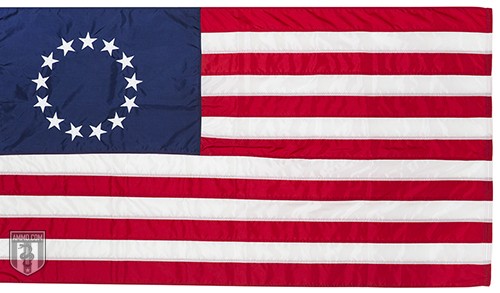Betsy Ross Flag: 5 Betsy Ross Flag Facts You Might Not Know and Their History
You're free to republish or share any of our articles (either in part or in full), which are licensed under a Creative Commons Attribution 4.0 International License. Our only requirement is that you give Ammo.com appropriate credit by linking to the original article. Spread the word; knowledge is power!
 Second only to Old Glory itself, the Betsy Ross Flag is the American icon. Its clean design is similar to our current flag, with 13 stripes and only 13 stars in a circle (representing the equal status of what were then the 13 united individual sovereign nations). This simplicity is perhaps the reason for its popularity among American Patriots and Constitutionalists, as it hearkens back to an earlier time when America was still a place of freedom and resistance to tyranny.
Second only to Old Glory itself, the Betsy Ross Flag is the American icon. Its clean design is similar to our current flag, with 13 stripes and only 13 stars in a circle (representing the equal status of what were then the 13 united individual sovereign nations). This simplicity is perhaps the reason for its popularity among American Patriots and Constitutionalists, as it hearkens back to an earlier time when America was still a place of freedom and resistance to tyranny.
But while this flag is the oldest attested flag for the American nation, many people don’t know its history. Who was Betsy Ross? And how did this iconic design become one of the strongest symbols of freedom?
1. Betsy Ross was shunned by Quakers and her family.
A Quaker like many in Pennsylvania, Betsy Ross was born Elizabeth Griscom. Once her education in public school ended, her father had her apprenticed to an upholsterer. It was at this job that she met her future husband, John Ross – an Episcopal and brother of George Ross, who signed the Declaration of Independence. Since the Quaker community frowned upon inter-denominational marriage, the two eloped when Betsy was 21 years old.
After the elopement, Betsy was estranged from her family and expelled from her Quaker congregation. Her husband died a few years later during the American Revolution. (Some have speculated that Betsy was the “beautiful young widow” who caught Carl von Donop’s eye after the Battle of Iron Works Hill.) It was after John Ross’ death that Betsy rejoined the Quakers – this time the Free Quakers, fighters who supported the war effort.
Joseph Ashburn, her second husband with whom she had two daughters, was arrested at sea and died in a British jail awaiting trial for treason. She married a third time and had five daughters, four of whom survived to adulthood.
2. The Betsy Ross Flag might not have been designed by Betsy Ross.
While Betsy Ross may not have designed the flag, legend around her supposed creation will live forever as part of American folklore. The story first started to circulate in popular consciousness around the 1876 centennial Allegedly passed down through the Ross family, Betsy Ross was said to have made the flag at the personal request of George Ross and America’s first president George Washington. An example for patriotic young girls around the time of the centennial, Betsy was given the design by Washington, Ross and another man named Robert Morris. (Morris was an early United States Senator and held a pre-Constitutional office roughly analogous to Secretary of the Treasury.)
Other than the say-so of her distant relatives, there is no evidence supporting Ross’ design and creation of the first American flag. However, much circumstantial evidence against her role includes no records of a flag design committee, no evidence that George Washington even knew who Betsy Ross was, and no mention in letters or diaries that have surfaced from the period. Betsy Ross was paid a significant sum by the Pennsylvania State Navy Board to make flags, but there’s no details about what those flags were.
3. The five-pointed star on the Betsy Ross flag was revolutionary.
Most people think the flag’s innovative design is the combination of stars and stripes – but these had existed in other pre-Constitutional American flags, including the Bennington Flag. The true innovation was in the stars themselves. According to legend, Betsy was given a design, but altered it by changing the common six-pointed star to the five-pointed star (which commonly appears on Old Glory to this day).
4. The Betsy Ross flag meaning remains a mystery.
There’s a common myth that the first flag was based on the Washington family coat of arms, which has since been discredited. One theory is that the stars represent their ancient meaning of man striving for something greater than himself. Some have speculated a connection between the stars and Freemasonry, but stars are not an important symbol in Freemasonry like pyramids or squares. The stripes may have come from the First Navy Jack, while the colors themselves are most likely (and somewhat ironically) from the Union Flag.
5. Betsy Ross American Flag possible design inspiration.
So who made the first American flag? No one is really sure, but the other big contender is Francis Hopkinson. He was a delegate from New Jersey to the Continental Congress, as well as a District Court Judge in Pennsylvania. He once asked for a quarter cask of wine in recognition of his efforts designing the American flag, but was never given this payment. He was also a noted writer of satire and poetry, with a building at the University of Pennsylvania named after him.
The iconic Betsy Ross flag lives on through tradition and history – it’s even attested in contemporaneous paintings of battles by John Trumbull and Charles Willson Peale. The patriotic symbol also adorns clothing brands, accessories, and souvenirs. And while we may not know who designed this symbol of freedom, one thing’s for sure: our search for the truth has never gotten in the way of a good story.
In the end, it doesn’t matter whether the story of the Betsy Ross Flag is true or not. It’s an American legend that will continue to inspire liberty for as long as this great country exists.
Flags
- Gonzales Flag: Meaning and History Behind "Come and Take It"
- The Fort Moultrie Flag: Southern Liberty During the American Revolution
- The Gadsden Flag History: Don't Tread On Me and the Gadsden Flag Meaning
- The Bennington Flag: A Pre-Constitutional Symbol of Freedom
- The Molon Labe Flag: Come and Take Them and the Ancient History of Modern Liberty
- Betsy Ross Flag: 5 Betsy Ross Flag Facts You Might Not Know and Their History
- Navy Jack Flag: History of the First Navy Jack and The Ultimate Symbol of Freedom
- The Sons of Liberty Flag: How The Rebellious Stripes Flag Shaped American Patriotism
- Don't Give Up the Ship: How The Commodore Perry Flag Inspired American Bravery & Tenacity
- The Culpeper Minutemen Flag: The History of the Banner Flown by a Militia of Patriots
- Bedford Flag History: Vince Aut Morire - The Forgotten History of The Conquer or Die Flag
